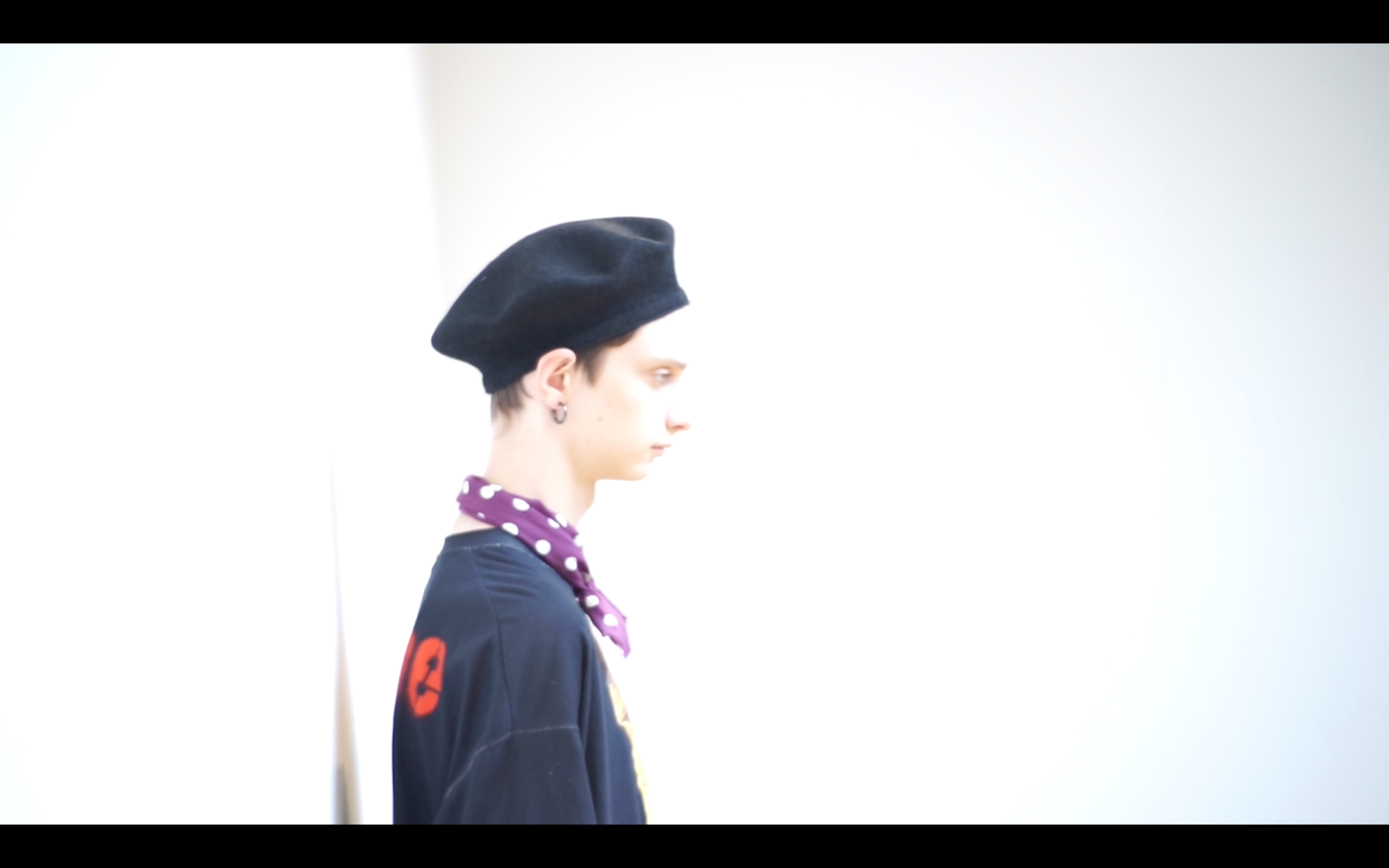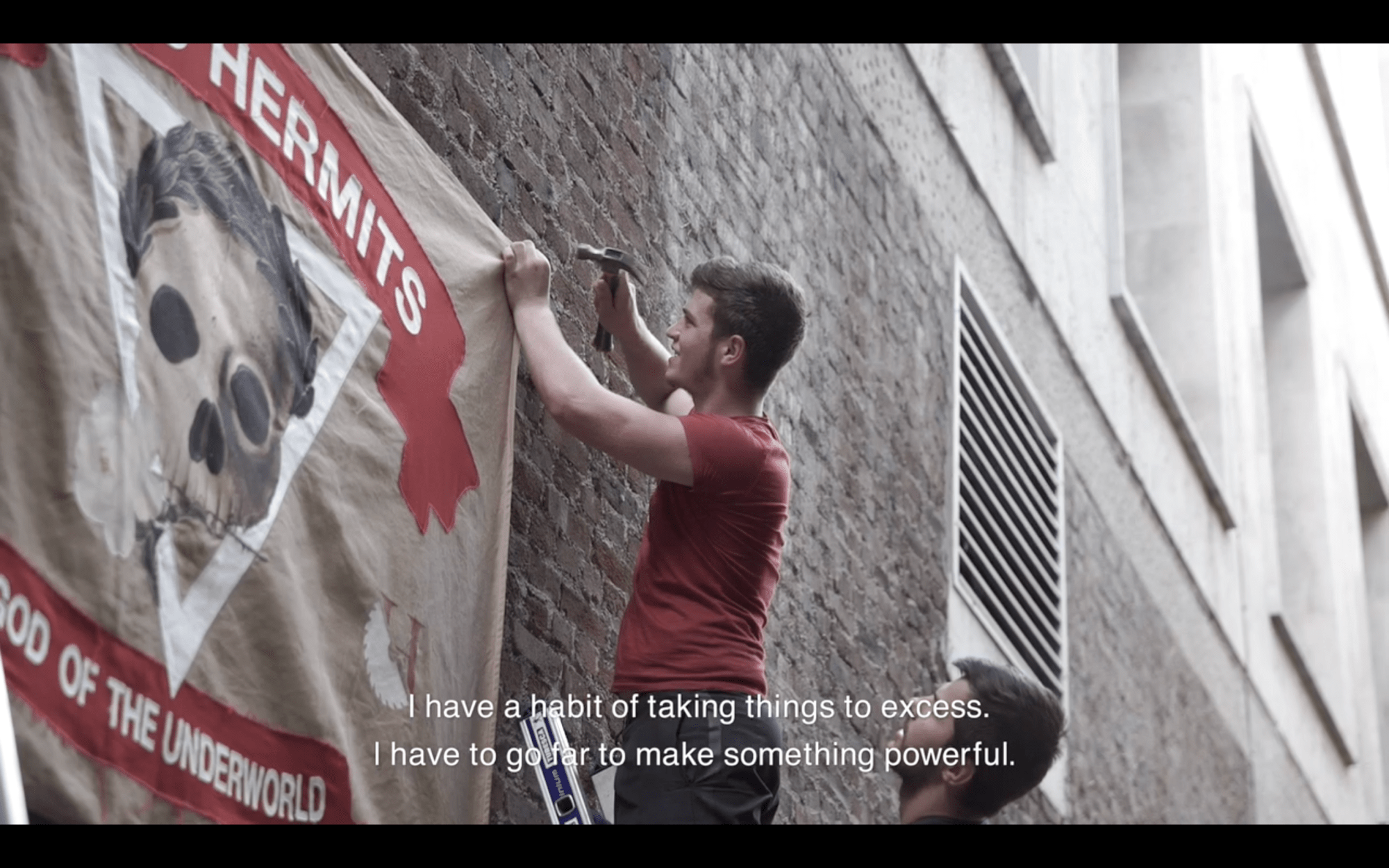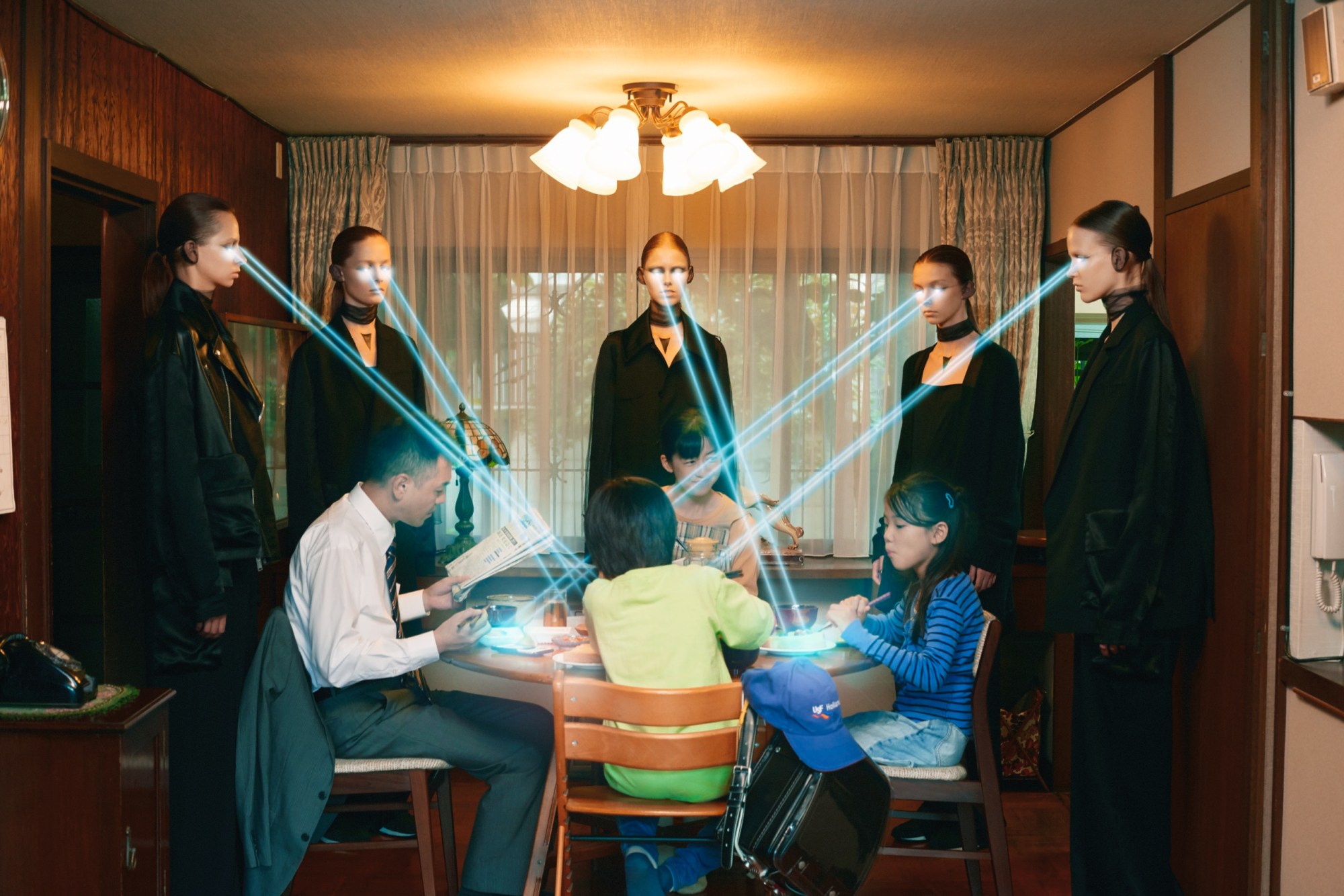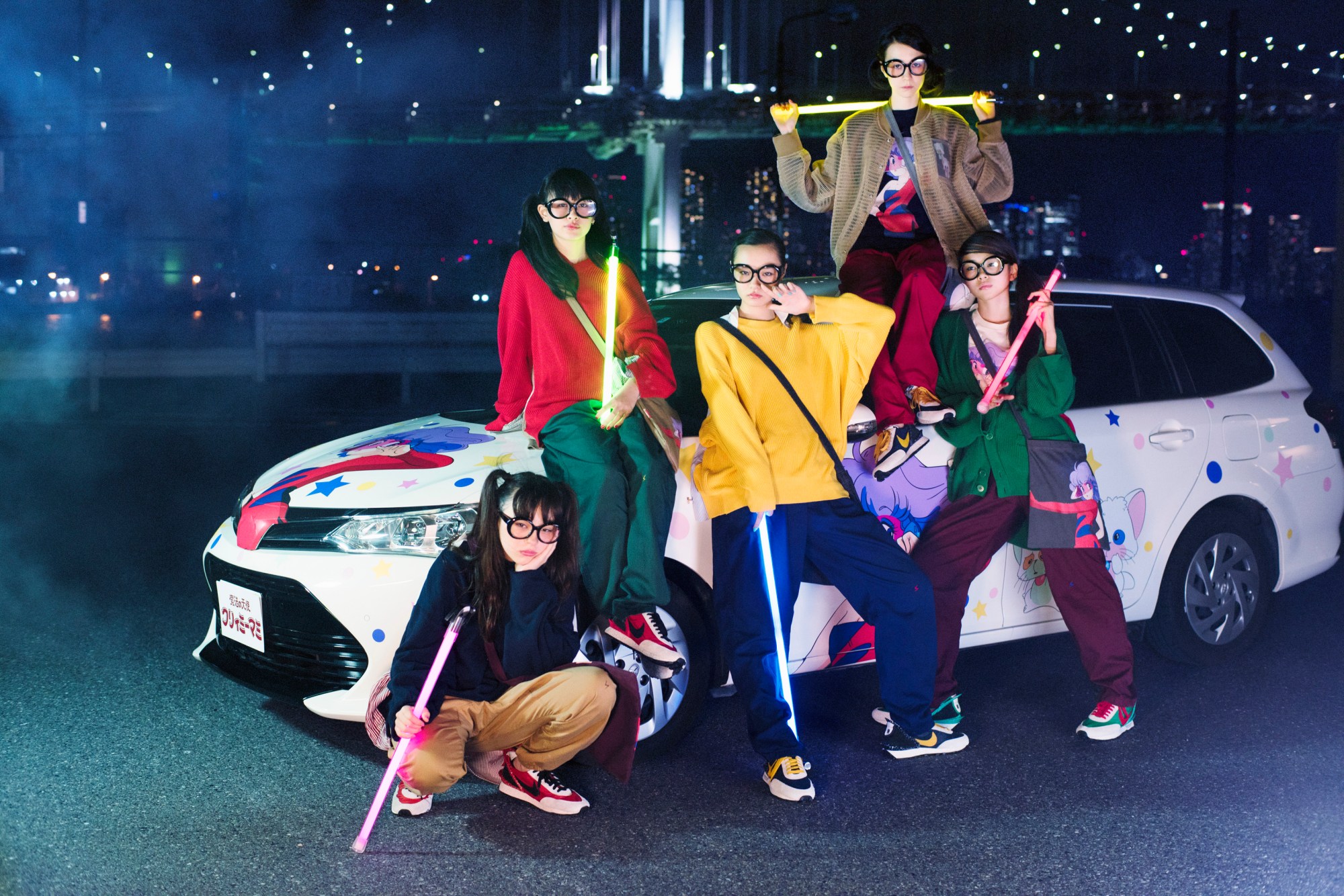Originally published by i-D Japan.
In December last year, with the second ever Undercover menswear show in Paris due to be take place the following month, i-D visited the label’s offices in Aoyama, Tokyo. On the studio floor the tension was palpable, yet designer Jun Takahashi exuded an easygoing, relaxed air as he came to greet us at the top of the stairs.
We were there to talk about the brand’s first ever solo menswear show in Paris, titled The New Warriors, which took place in summer of 2018. It drew inspiration from Walter Hill’s cult 1979 film The Warriors, and its dystopia of warring street gangs that rule New York. Imagining eight tribes of young men, each flying the flag for a different creed, Undercover wove an imaginary narrative represented by the clothes they wore. We met the Bloody Geekers, nerds with anime character Creamy Mami, the Magic Angel splashed across their chests; the Larms, vegetarian psychics who communicate telepathically; the Zoruge tribe that believe that kaiju monsters will soon descend upon Osaka; the solutitude-loving X Shadow Hoppers; the BMX riding Zenmondooo; The Dead Hermits that keep to themselves; the gothic Vlads; and the Bootleg Truth tribe who follow ancient Scottish traditions.
“The biggest thing was to be able to show lots of different sides of Undercover in a single show,” Takahashi says of the collection. The New Warriors’ world is one in which hyper-individualistic tribes with their fictional backstories, their differing styles and philosophies, coexist side by side. The intricacy is a testament to the unique sensibilities of Takahashi, and his gift for storytelling through fashion. “We took what we’d done so far, from the punky stuff right through to the folky stuff, mixed it all together with a bunch of new angles thrown in, and then spread that across the collection as a whole,” he says. We sat down with Takahashi to find out more about his process.
For autumn/winter 2018 you took a break from womenswear shows, and announced a menswear show. Can you explain this shift, and if it marks a turning point for the brand?
Yes, the shift to menswear did mark a turning point. But in truth, I won’t know how long I can continue with the current approach without trying it out. If I want to do womenswear again in the future, then I’ll do it. At the moment, the important thing is to do things I find interesting, things I really want to do. Coming up with elaborate plans for the future and forcing myself to do things I’ve judged to be best aren’t approaches that work for me.
Tell us about your reasons for deciding to do a menswear show?
Over the past two or three years, I’ve begun for the first time to enjoy designing menswear. Quite simply, I started to understand how to take the street culture, or music, or films, or art or other things that influence me, channel them through my own filter, and incorporate them into the things I want to wear myself. And around the same point in time, I reached a point where I felt like I could take the worlds I’ve been expressing through my womenswear shows, and the imaginary stories and fiction-inspired styles which Undercover is all about, and do the same kind of thing for menswear too. When I realised that, I thought I’d give it a go.

You’ve said before that you have a tendency to do things to excess — that without doing so, you can’t produce powerful work. In what way is that crucial in creating a particular world in your shows?
In the case of menswear, none of the pieces are really that extreme if you look at them individually. I view the fashion show as a form of entertainment, so I want to see how much of a sense of a world I can create by combining those pieces, and I believe that that’s what the audience wants to see too. I build up that sense by adding in a lot of different aspects. I’m the exact opposite of those kinds of designers who make really minimalist clothes and photograph them very simply. So not just in my shows but in my lookbooks too, I feel like the excess is needed in the way the clothes are shown and styled — the elements that come after the design, in other words.
The young people making up the tribes are all devoted to and believe in very different things. In your world they all coexist, though in the film, of course, they are in conflict…
That’s right. I’ve divided them up into tribes, but I didn’t make them fight. So this direction I took the idea in, where the tribes all peaceably cohabit a world, differs a bit from the film. Personally speaking, I think that in our current climate, the idea of all these diverse people coexisting is interesting. That’s definitely one of the things I set out to say with the show.

At the very end of the documentary, you say that after turning 40 you felt you wanted to be more aggressive. That left a big impression.
In my case, from the moment that I began the brand, being in the attacking stance, thinking in that way, has been very much my default position. When I go on the defensive, I feel like I’m no longer myself. I sometimes hang around with people in their twenties, and I feel like I understand them well, they feel very relatable to me. At those times, I’m sometimes reminded of things that I don’t want to lose sight of. I’d like to make sure I maintain this kind of energy forever, if possible.
This documentary is the second piece of work by your creative agency Undercover Production (UCP) — what are your aims for it?
I’ve been working with the other three [photographers Taro Mizutani and Katsuhide Morimoto and art director Tetsuya Nagato run UCP with Jun] for many years, I trust them a great deal, and we also hang out together all the time. I feel like all four of our sensibilities are a little bit unusual — we’re all kind of weird, you could say. None of us could do it alone, but if it’s the four of us, we can brainstorm ideas, and then make them into adverts, films and products and so on. We felt like stepping into those kinds of industries might be interesting. Of course we intend to do this not just within Japan, but internationally. But really, rather than planning in what direction we want to take it, it’s more a question of how it’d be kind of fun for four loonies like us to get together and do stuff.

Do you think the world needs more independent production companies like UCP?
Yes, I really do. Young people should be doing this stuff too. In a lot of ways, I think Japan is really behind other countries, and I think we need to see advertising agencies with their own unique stance. I feel very strongly that, just as with politics, that the structure itself has to change. For example, mainstream music and other forms of culture in Japan are just awful. On the other hand, there are loads of really interesting, cool young people out there. Though I think there’s a chance that in the near future, we might find ourselves in a situation where even those people aren’t allowed to express themselves in the way that they want to. Then we’d truly be in trouble.
Do you ever think about whether there’s anything that Undercover can do about that?
I don’t want to enter into political territory, so I don’t want to do anything with Undercover in that sense. But I do want to convey the sensation of freedom from a prominent position in society, through the use of powerful imagery of the kind that nobody else produces.

The Seventh Sense womenswear collection lookbook, which featured your daughter Lala, has some really intense visuals.
Yes, that’s the most powerful thing we’ve done I think. The models are all Lala’s friends, and most of them are still in their teens. They’re so full of energy, and watching how Lala is, the music she listens to and the unique friends she brings along is truly fascinating. Of course it’s different to how it was when I was young, but somehow that sensation felt familiar to me. It’s strange when you feel that you have that kind of connection with someone on a sensory level.
Do the other members of UCP share your desire to communicate to younger generations through what they create?
Although we all do very different things, that’s a belief we all share. It’s essential to communicate with young people and establish links to people of that generation—and that applies even when it’s stuff like four people like us coming together. Of course speaking to people older than you, who’ve trodden the same path ahead of you, is also important. I don’t think it matters if people around you think that you’re just being stupid. There are too few people being stupid these days. The imagery, the music and so on that you saw when you were young is reflected in the person you are now. When young kids see stuff that you’ve made based on those influences, then those things can be passed down to the next generation. That’s why I think that continuing to create things through your own filter, to provide new interpretations, is hugely important. To have someone think, ‘Ah, so this is valid too.’

Translation by Polly Barton.
